The Impact of Urbanization on the Relationship between Carbon Storage Supply and Demand in Mega-Urban Agglomerations and Response Measures: A Case of Yangtze River Delta Region, China
Abstract
1. Introduction
2. Theoretical Framework
3. Materials and Methods
3.1. Study Area
3.2. Data Sources
3.3. Combined Urbanization Level (CUL)
3.4. Carbon Storage Supply and Demand
3.5. Quantify the Impact of Urbanization on CSD
3.6. CSD Response to Urbanization
- (1)
- Identification of priority conservation areas for carbon storage supply using Marxan model.
- (2)
- Building a carbon compensation scheme based on the grandfather principle and the carbon efficiency principle.
- (3)
- Identification of urbanization development thresholds through regression model.
4. Results
4.1. Urbanization and CSD Characteristics
4.1.1. CUL of YRD
4.1.2. CSD of YRD
4.2. Impact of Urbanization on CSD
4.2.1. The Relationship between Urbanization and CSD
4.2.2. Strength of Urbanization Impact on CSDR
4.3. CSD Response Measures
4.3.1. Priority Conservation Areas for Carbon Storage Supply
4.3.2. Construct Carbon Compensation Scheme
4.3.3. Identify Thresholds of YRD Urbanization
5. Discussion
5.1. Comparison with Previous Studies
5.2. Implication for Ecological Management
5.3. Limitations
6. Conclusions
Supplementary Materials
Author Contributions
Funding
Institutional Review Board Statement
Informed Consent Statement
Data Availability Statement
Conflicts of Interest
Abbreviations
| CSD | carbon storage supply and demand |
| ES | ecosystem services |
| YRD | Yangtze River Delta Region |
| CSDR | carbon storage supply and demand ratio |
| SES | social-ecological systems |
| CUL | combined urbanization level |
| POP | population density |
| GDP | GDP density |
| ALP | artificial land proportion |
References
- Fang, C.L.; Yu, D.L. Urban agglomeration: An evolving concept of an emerging phenomenon. Landsc. Urban Plan. 2017, 162, 126–136. [Google Scholar] [CrossRef]
- Fang, C.L.; Zhou, C.H.; Gu, C.L.; Chen, L.; Li, S. Theoretical analysis of interactive coupled effects between urbanization and eco-environment in mega-urban agglomerations. Acta Geogr. Sin. 2016, 71, 531–550. (In Chinese) [Google Scholar] [CrossRef]
- Galina, C. The Role of Urbanization in the Global Carbon Cycle. Front. Ecol. Evol. 2016, 3, 144. [Google Scholar] [CrossRef]
- Deng, C.; Liu, J.; Liu, Y.; Li, Z.; Nie, X.; Hu, X.; Wang, L.; Zhang, Y.; Zhang, G.; Zhu, D.; et al. Spatiotemporal dislocation of urbanization and ecological construction increased the ecosystem service supply and demand imbalance. J. Environ. Manag. 2021, 288, 112478. [Google Scholar] [CrossRef] [PubMed]
- Pouyat, R.V.; Yesilonis, I.D.; Nowak, D.J. Carbon Storage by Urban Soils in the United States. J. Environ. Qual. 2006, 35, 1566–1575. [Google Scholar] [CrossRef] [PubMed]
- Xu, Q.; Dong, Y.-X.; Yang, R. Urbanization impact on carbon emissions in the Pearl River Delta region: Kuznets curve relationships. J. Clean. Prod. 2018, 180, 514–523. [Google Scholar] [CrossRef]
- Zhang, X.; Brandt, M.; Tong, X.; Ciais, P.; Yue, Y.; Xiao, X.; Zhang, W.; Wang, K.; Fensholt, R. A large but transient carbon sink from urbanization and rural depopulation in China. Nat. Sustain. 2022, 5, 321–328. [Google Scholar] [CrossRef]
- Fang, J.-Y. Ecological perspectives of carbon neutrality. Chin. J. Plant Ecol. 2021, 45, 1173–1176. (In Chinese) [Google Scholar] [CrossRef]
- Muñoz, P.; Zwick, S.; Mirzabaev, A. The impact of urbanization on Austria’s carbon footprint. J. Clean. Prod. 2020, 263, 121326. [Google Scholar] [CrossRef]
- Farhani, S.; Ozturk, I. Causal relationship between CO2 emissions, real GDP, energy consumption, financial development, trade openness, and urbanization in Tunisia. Environ. Sci. Pollut. Res. 2015, 22, 15663–15676. [Google Scholar] [CrossRef]
- Han, J.; Meng, X.; Zhou, X.; Yi, B.; Liu, M.; Xiang, W.-N. A long-term analysis of urbanization process, landscape change, and carbon sources and sinks: A case study in China's Yangtze River Delta region. J. Clean. Prod. 2017, 141, 1040–1050. [Google Scholar] [CrossRef]
- Sadorsky, P. The effect of urbanization on CO2 emissions in emerging economies. Energy Econ. 2014, 41, 147–153. [Google Scholar] [CrossRef]
- Sun, W.; Huang, C.C. How does urbanization affect carbon emission efficiency? Evidence from China. J. Clean. Prod. 2020, 272, 122828. [Google Scholar] [CrossRef]
- Wang, Q.; Li, L. The effects of population aging, life expectancy, unemployment rate, population density, per capita GDP, urbanization on per capita carbon emissions. Sustain. Prod. Consum. 2021, 28, 760–774. [Google Scholar] [CrossRef]
- Zhou, C.S.; Wang, S.J.; Wang, J.Y. Examining the influences of urbanization on carbon dioxide emissions in the Yangtze River Delta, China: Kuznets curve relationship. Sci. Total Environ. 2019, 675, 472–482. [Google Scholar] [CrossRef]
- Li, J.; Huang, X.; Chuai, X.; Yang, H. The impact of land urbanization on carbon dioxide emissions in the Yangtze River Delta, China: A multiscale perspective. Cities 2021, 116, 103275. [Google Scholar] [CrossRef]
- Adeneye, Y.B.; Jaaffar, A.H.; Ooi, C.A.; Ooi, S.K. Nexus Between Carbon Emissions, Energy Consumption, Urbanization and Economic Growth in Asia: Evidence from Common Correlated Effects Mean Group Estimator (CCEMG). Front. Energy Res. 2021, 8, 415. [Google Scholar] [CrossRef]
- Khan, K.; Su, C.W. Urbanization and carbon emissions: A panel threshold analysis. Sci. Pollut. Res. 2021, 28, 26073–26081. [Google Scholar] [CrossRef]
- Martínez-Zarzoso, I.; Maruotti, A. The impact of urbanization on CO2 emissions: Evidence from developing countries. Ecol. Econ. 2011, 70, 1344–1353. [Google Scholar] [CrossRef]
- Ghazali, A.; Ali, G. Investigation of key contributors of CO2 emissions in extended STIRPAT model for newly industrialized countries: A dynamic common correlated estimator (DCCE) approach. Energy Rep. 2019, 5, 242–252. [Google Scholar] [CrossRef]
- Li, Y.; Zhao, R.; Liu, T.; Zhao, J. Does urbanization lead to more direct and indirect household carbon dioxide emissions? Evidence from China during 1996–2012. J. Clean. Prod. 2015, 102, 103–114. [Google Scholar] [CrossRef]
- Xu, Q.; Dong, Y.-X.; Yang, R. Influence of land urbanization on carbon sequestration of urban vegetation: A temporal cooperativity analysis in Guangzhou as an example. Sci. Total Environ. 2018, 635, 26–34. [Google Scholar] [CrossRef] [PubMed]
- Hutyra, L.R.; Yoon, B.; Hepinstall-Cymerman, J.; Alberti, M. Carbon consequences of land cover change and expansion of urban lands: A case study in the Seattle metropolitan region. Landsc. Urban Plan. 2011, 103, 83–93. [Google Scholar] [CrossRef]
- Xu, Q.; Yang, R.; Dong, Y.-X.; Liu, Y.-X.; Qiu, L.-R. The influence of rapid urbanization and land use changes on terrestrial carbon sources/sinks in Guangzhou, China. Ecol. Indic. 2016, 70, 304–316. [Google Scholar] [CrossRef]
- Song, S.; Wang, S.; Fu, B.J.; Chen, H.; Liu, Y.; Zhao, W. Study on adaptive governance of social-ecological system: Progress and prospect. Acta Geogr. Sin. 2019, 74, 2401–2410. (In Chinese) [Google Scholar] [CrossRef]
- Ostrom, E. A General Framework for Analyzing Sustainability of Social-Ecological Systems. Science 2009, 325, 419–422. [Google Scholar] [CrossRef]
- Wang, S.; Fu, B.; Wu, X.; Wang, Y. Dynamics and sustainability of social-ecological systems in the Loess Plateau. Resour. Sci. 2020, 42, 96–103. [Google Scholar] [CrossRef]
- Haines-Young, R.H.; Potschin, M. The Links between Biodiversity, Ecosystem Services and Human Well-Being; Cambridge University Press: Cambridge, UK, 2010. [Google Scholar]
- Zhang, C.; Li, J.; Zhou, Z. Ecosystem service cascade: Concept, review, application and prospect. Ecol. Indic. 2022, 137, 108766. [Google Scholar] [CrossRef]
- Nassl, M.; Löffler, J. Ecosystem services in coupled social–ecological systems: Closing the cycle of service provision and societal feedback. Ambio 2015, 44, 737–749. [Google Scholar] [CrossRef]
- Yang, Y.-N.; Li, J.; Wang, L.; Wang, Z.-H.; Yao, C.-X.; Wang, Y. Impact of urbanization on supply and demand of typical ecosystem services in Yangtze River Delta. J. Nat. Resour. 2022, 37, 1555–1571. (In Chinese) [Google Scholar] [CrossRef]
- Zhang, L.; Ren, Z.; Chen, B.; Gong, P.; Fu, H.; Xu, B. A Prolonged Artificial Nighttime-Light Dataset of China (1984-2020); National Tibetan Plateau Data Center: Beijing, China, 2021. [Google Scholar] [CrossRef]
- Bai, X.; Shi, P.; Liu, Y. Realizing China's urban dream. Nature 2014, 509, 158–160. [Google Scholar] [CrossRef] [PubMed]
- Peng, J.; Tian, L.; Liu, Y.; Zhao, M.; Hu, Y.; Wu, J. Ecosystem services response to urbanization in metropolitan areas: Thresholds identification. Sci. Total Environ. 2017, 607–608, 706–714. [Google Scholar] [CrossRef] [PubMed]
- Pan, Z.; Wang, J. Spatially heterogeneity response of ecosystem services supply and demand to urbanization in China. Ecol. Eng. 2021, 169, 106303. [Google Scholar] [CrossRef]
- Zhu, E.Y.; Qi, Q.Y.; Chen, L.S.; Wu, X. The spatial-temporal patterns and multiple driving mechanisms of carbon emissions in the process of urbanization: A case study in Zhejiang, China. J. Clean. Prod. 2022, 358, 131954. [Google Scholar] [CrossRef]
- Deng, J.S.; Wang, K.; Hong, Y.; Qi, J.G. Spatio-temporal dynamics and evolution of land use change and landscape pattern in response to rapid urbanization. Landsc. Urban Plan. 2009, 92, 187–198. [Google Scholar] [CrossRef]
- Carlson, T.N.; Traci Arthur, S. The impact of land use—Land cover changes due to urbanization on surface microclimate and hydrology: A satellite perspective. Glob. Planet. Chang. 2000, 25, 49–65. [Google Scholar] [CrossRef]
- Chen, G.S.; Yang, Y.S.; Xie, J.S.; Du, Z.; Zhang, J. Total belowground carbon allocation in China’s forests. Acta Ecol. Sin. 2007, 27, 5148–5157. (In Chinese) [Google Scholar]
- Alam, S.; Starr, M.; Clark, B. Tree biomass and soil organic carbon densities across the Sudanese woodland savannah: A regional carbon sequestration study. J. Arid Environ. 2013, 89, 67–76. [Google Scholar] [CrossRef]
- Giardina, C.P.; Ryan, M. Evidence that decomposition rates of organic carbon in mineral soil do not vary with temperature. Nature 2000, 404, 858–861. [Google Scholar] [CrossRef]
- Guo, Y.; Peng, C.; Trancoso, R.; Zhu, Q.; Zhou, X. Stand carbon density drivers and changes under future climate scenarios across global forests. For. Ecol. Manag. 2019, 449, 117463. [Google Scholar] [CrossRef]
- IPCC. Ipcc Guidelines for National Greenhouse Gas Inventories; Institute for Global Environmental Strategies: Kanagawa, Japan, 2006. [Google Scholar]
- Breiman, L. Random forests. Mach. Learn. 2001, 45, 5–32. [Google Scholar] [CrossRef]
- Miao, Y.; Kong, C.; Wang, L.; Mu, J.; Lu, X.; Bao, J.; Li, H. A provincial lateral carbon emissions compensation plan in China based on carbon budget perspective. Sci. Total Environ. 2019, 692, 1086–1096. [Google Scholar] [CrossRef] [PubMed]
- Yang, G.; Shang, P.; He, L.; Zhang, Y.; Wang, Y.; Zhang, F.; Zhu, L.; Wang, Y. Interregional carbon compensation cost forecast and priority index calculation based on the theoretical carbon deficit: China as a case. Sci. Total Environ. 2019, 654, 786–800. [Google Scholar] [CrossRef]
- Chen, J.; Jiang, B.; Bai, Y.; Xu, X.; Alatalo, J.M. Quantifying ecosystem services supply and demand shortfalls and mismatches for management optimisation. Sci. Total Environ. 2018, 650, 1426–1439. [Google Scholar] [CrossRef] [PubMed]
- Gao, J.; Wang, L. Embedding spatiotemporal changes in carbon storage into urban agglomeration ecosystem management—A case study of the Yangtze River Delta, China. J. Clean. Prod. 2019, 237, 117764. [Google Scholar] [CrossRef]
- Sun, W.; Li, D.; Wang, X.; Li, R.; Li, K.; Xie, Y. Exploring the scale effects, trade-offs and driving forces of the mismatch of ecosystem services. Ecol. Indic. 2019, 103, 617–629. [Google Scholar] [CrossRef]
- Zhang, Z.; Peng, J.; Xu, Z.; Wang, X.; Meersmans, J. Ecosystem services supply and demand response to urbanization: A case study of the Pearl River Delta, China. Ecosyst. Serv. 2021, 49, 101274. [Google Scholar] [CrossRef]
- Yan, J.; Yang, J. Carbon pricing and income inequality: A case study of Guangdong Province, China. J. Clean. Prod. 2021, 296, 126491. [Google Scholar] [CrossRef]
- Wang, W.; Wang, W.; Xie, P.; Zhao, D. Spatial and temporal disparities of carbon emissions and interregional carbon compensation in major function-oriented zones: A case study of Guangdong province. J. Clean. Prod. 2020, 245, 118873. [Google Scholar] [CrossRef]
- Hlab, C.; Zga, B.; Jwa, B.; Zca, B. GDP spatialization in ningbo city based on NPP/VIIRS night-time light and auxiliary data using random forest regression. Adv. Space Res. 2020, 65, 481–493. [Google Scholar] [CrossRef]
- Zhu, C.; Zhao, S.Q.; Zhou, D.C. Organic carbon storage in urban built-up areas of china in 1997–2006. Chin. J Appl. Ecol. 2012, 23, 1195–1202. (In Chinese) [Google Scholar] [CrossRef]
- Li, K.R.; Wang, S.Q.; Cao, M.K. Vegetation and soil carbon storage in China. Sci. Sin. Terrae 2003, 33, 72–80. (In Chinses) [Google Scholar] [CrossRef]
- Piao, S.L.; Fang, J.Y.; He, J.S.; Xiao, Y. Spatial Distribution of Grassland Biomass in China. Acta Phyto. Sin. 2004, 28, 491–498. (In Chinses) [Google Scholar]
- Yang, J. Study on Grassland Ecosystem Service and Its Trade-Off and Synergy in the Yellow River Basin; Gansu Agricultural University: Lanzhou, China, 2021; (In Chinese). [Google Scholar] [CrossRef]
- Pan, J.H.; Zhang, Y.N. Spatiotemporal patterns of energy carbon footprint and decoupling effect in China. Acta Geogr. Sin. 2021, 76, 206–222. (In Chinese) [Google Scholar] [CrossRef]
- Ball, I.R.; Possingham, H.P.; Watts, M. Marxan and Relatives: Software for Spatial Conservation Prioritization; Oxford University Press: Oxford, UK, 2009. [Google Scholar]
- McDonnell, M.D.; Possingham, H.; Ball, I.R.; Cousins, E. Mathematical models for spatially cohesive reserve design. Environ. Model. Assess. 2002, 7, 107–114. [Google Scholar] [CrossRef]
- Serra-Sogas, N.; Kockel, A.; Game, E.T.; Grantham, H.; Possingham, H.P.; McGowan, J. Marxan User Manual 2021 [EB/OL]. 2021. Available online: https://marxansolutions.org/software/# (accessed on 20 April 2022).

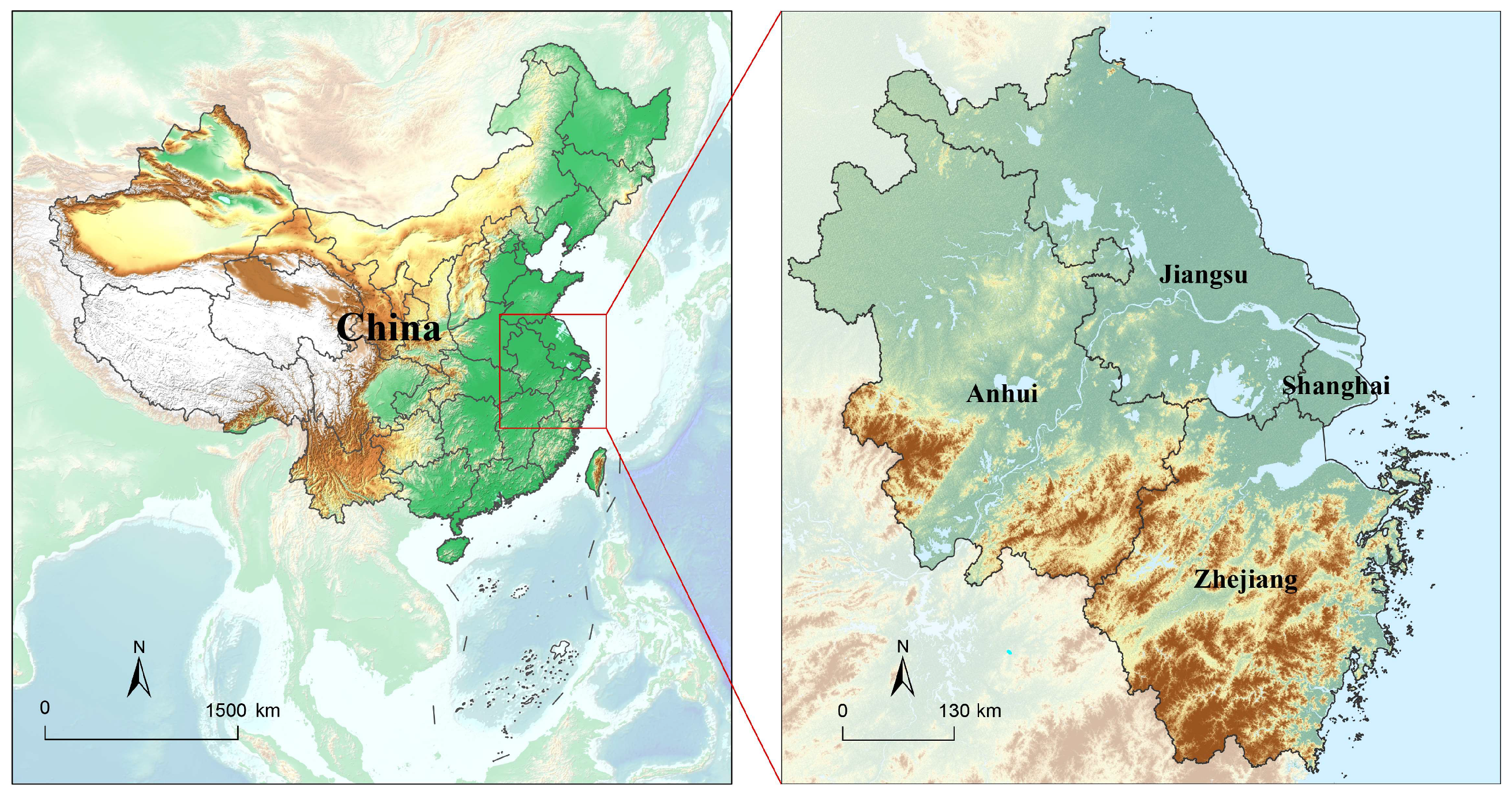


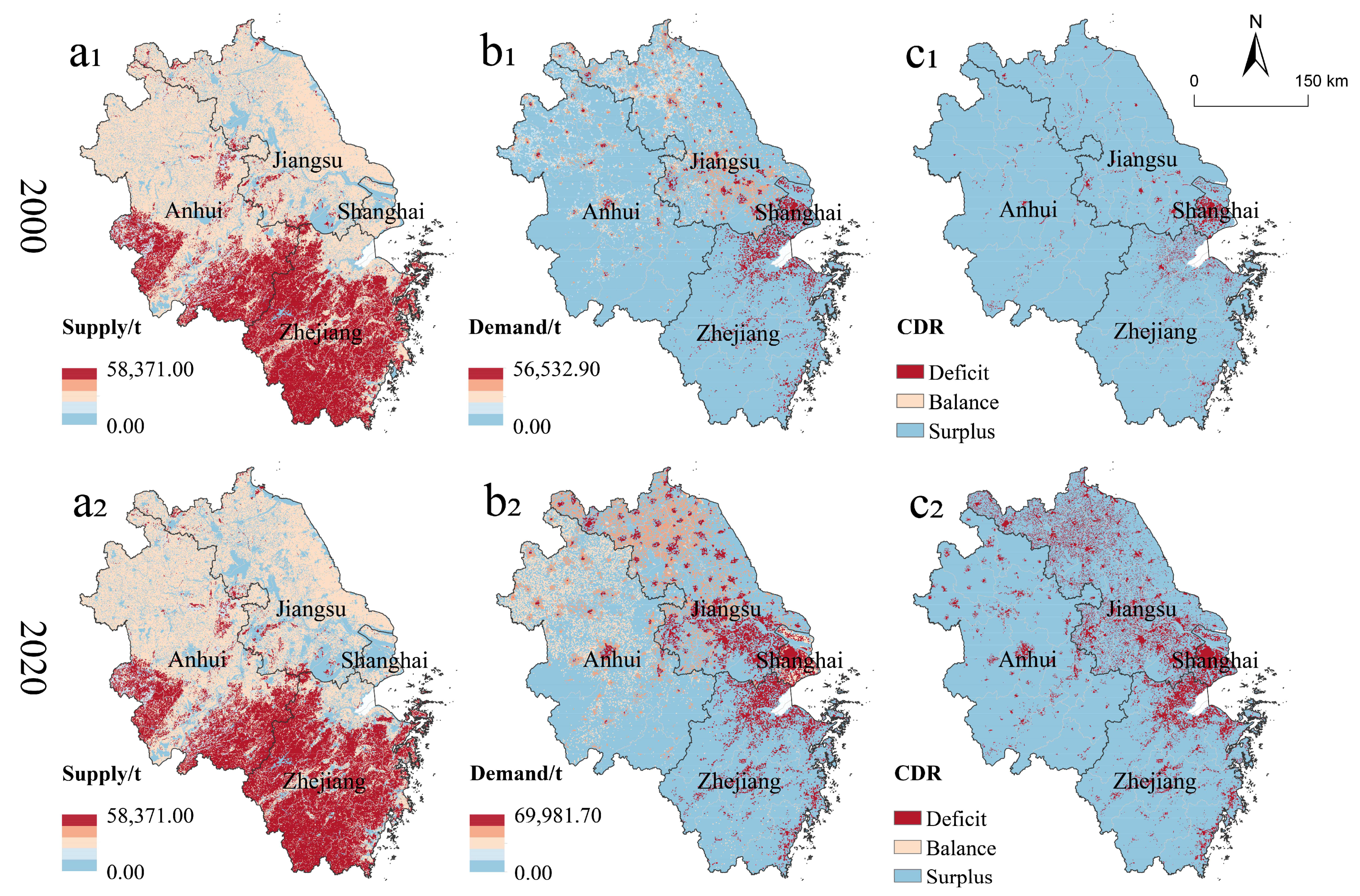
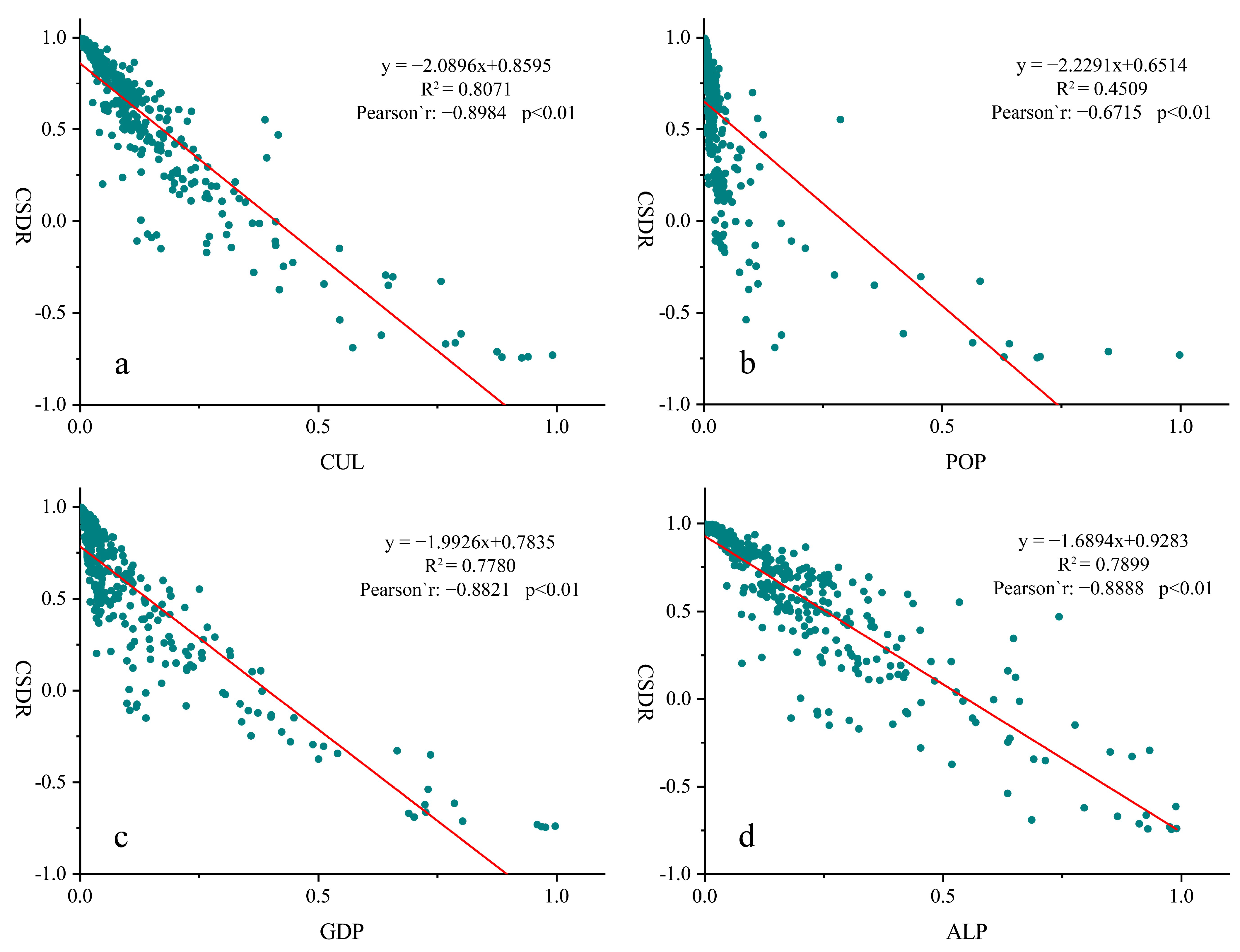
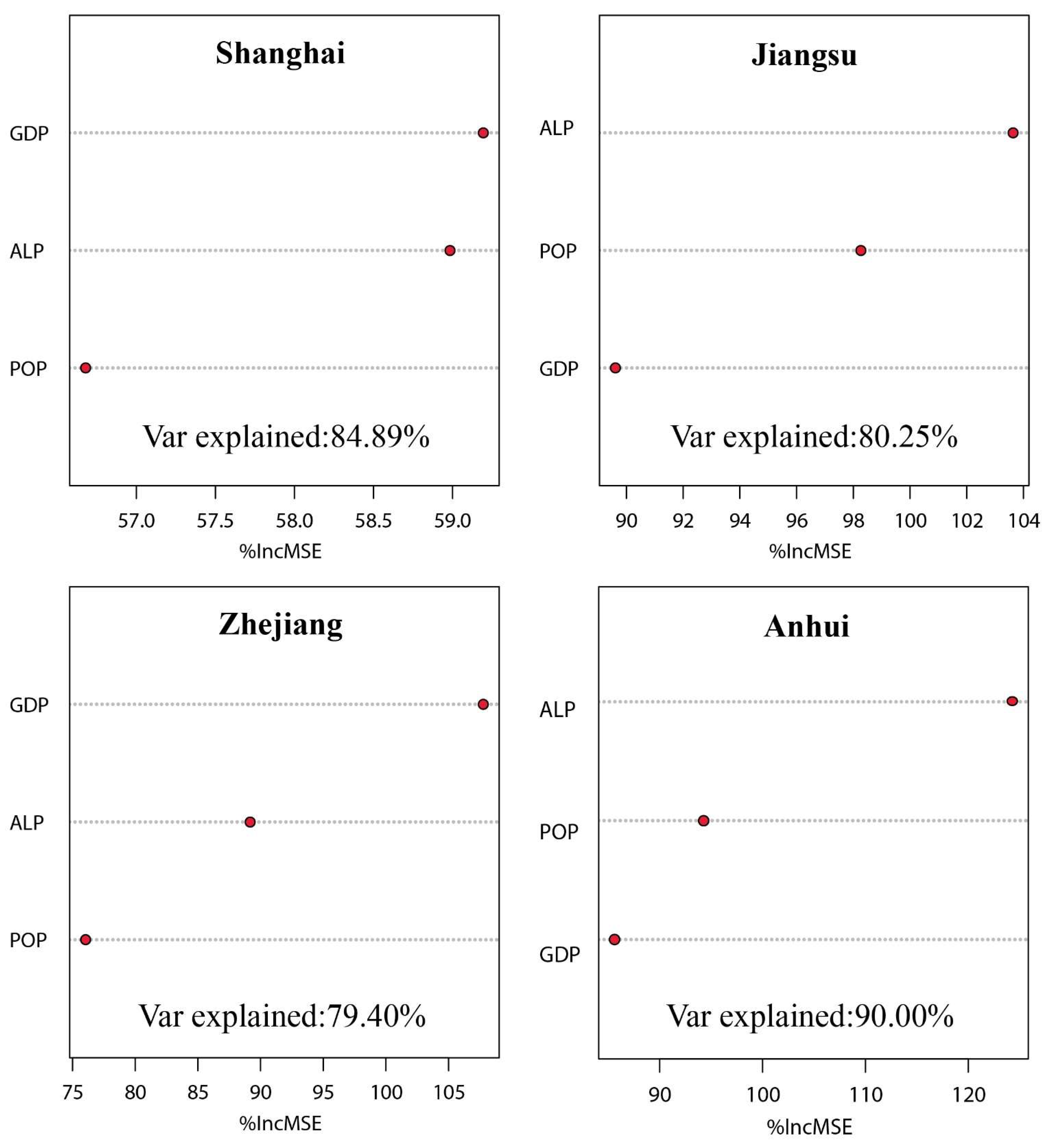

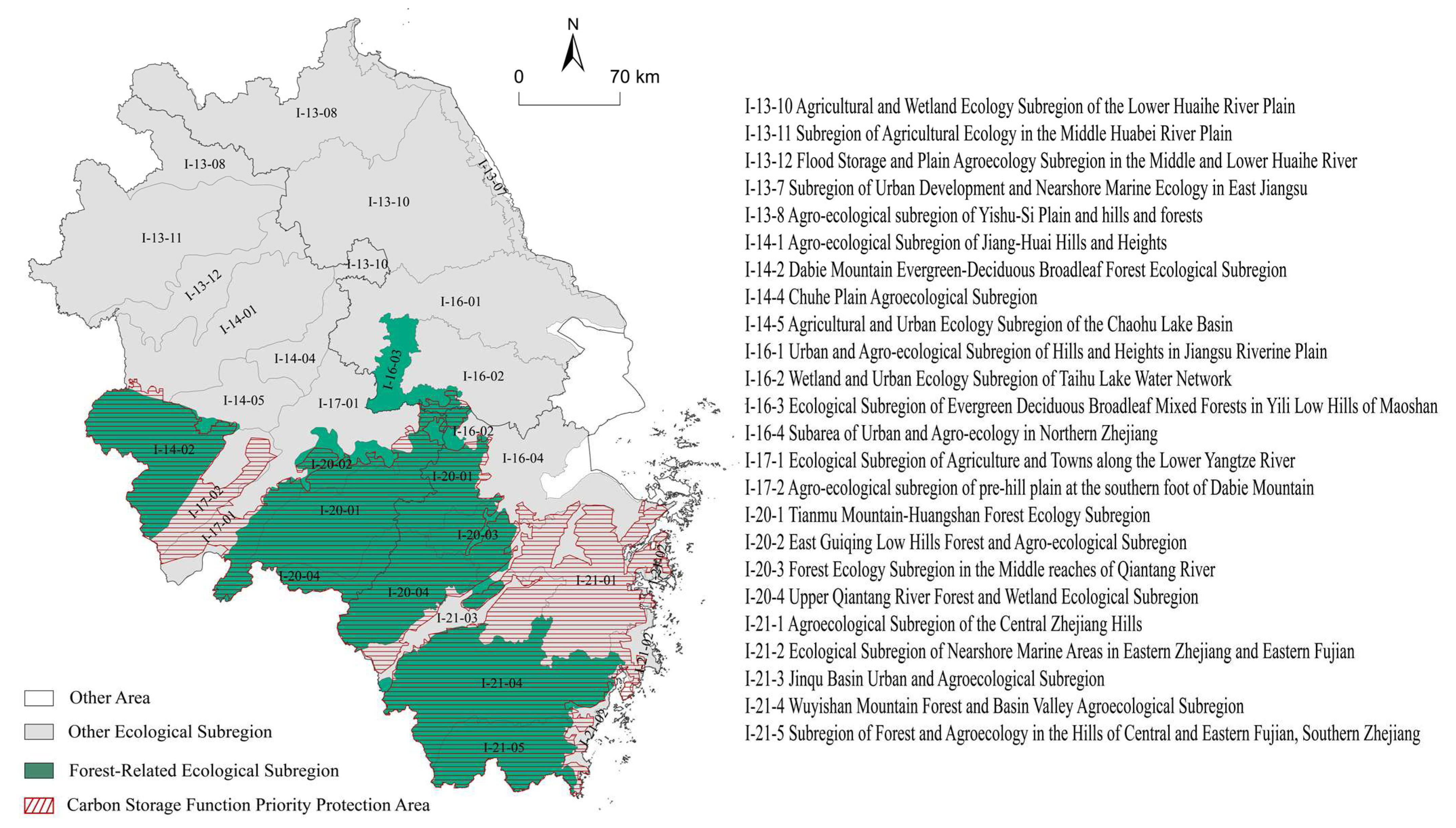
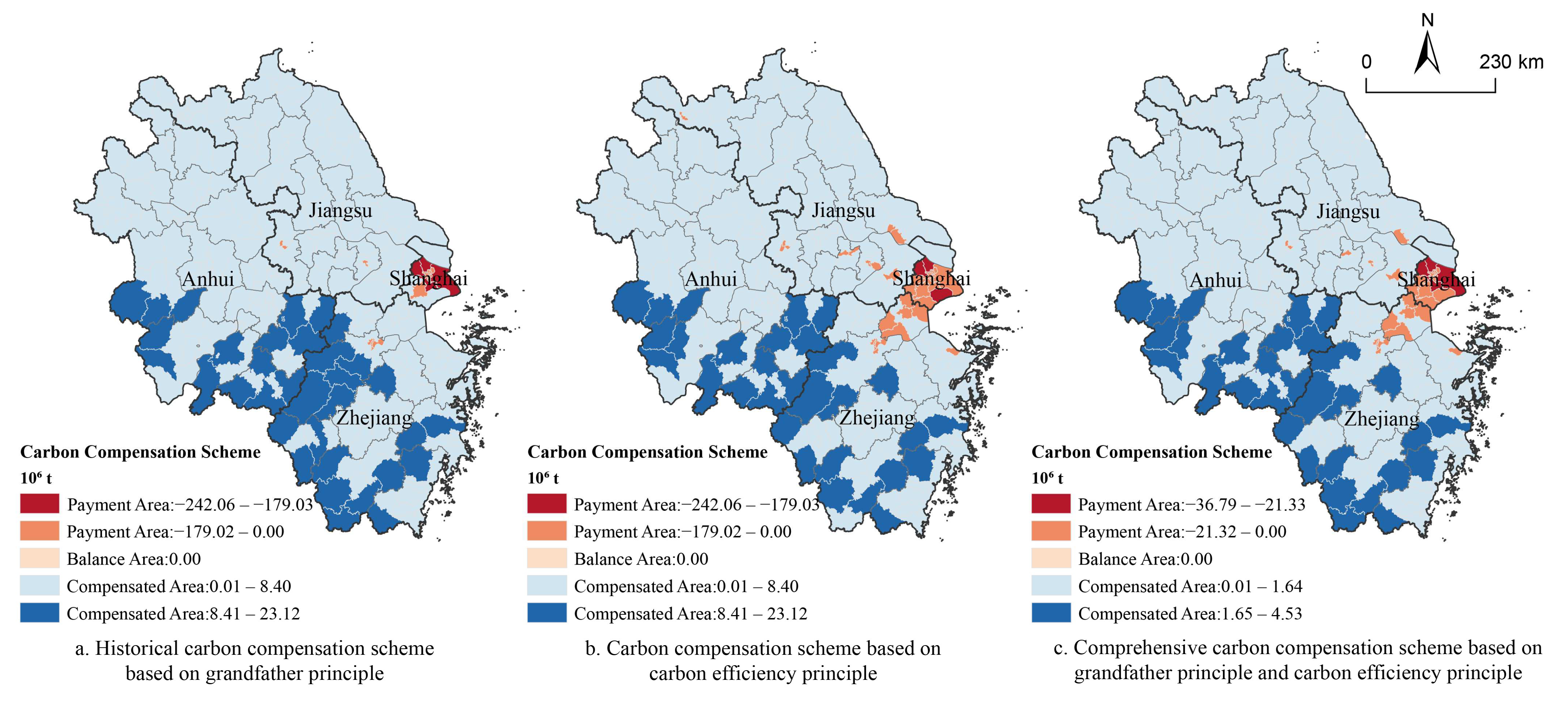
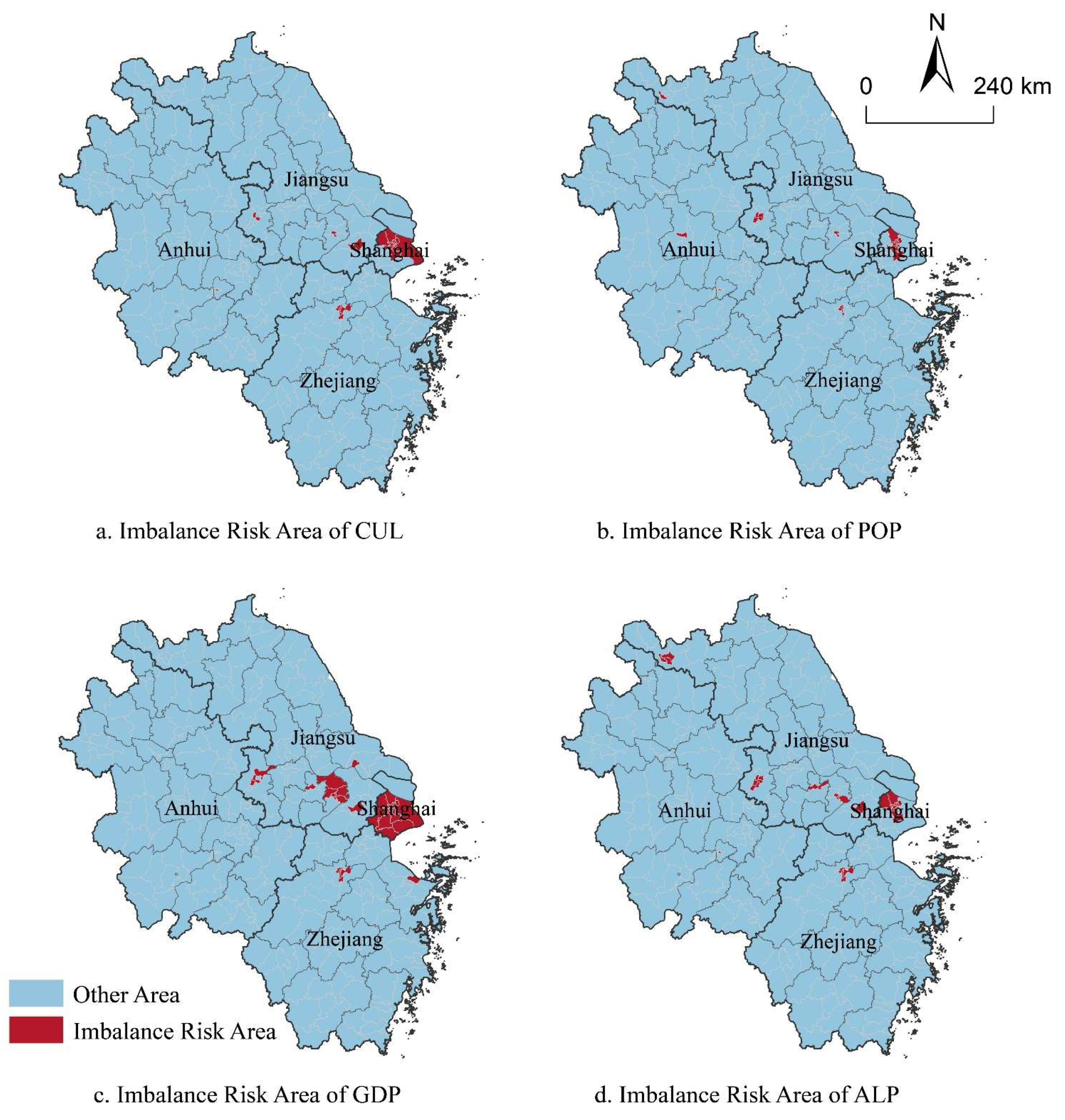
| Index | Regression Prediction Model | R2 | Threshold |
|---|---|---|---|
| POP | 0.7337 | 5674.70 (people/ km2) | |
| GDP | 0.8330 | 0.3807 (Billion/km2) | |
| ALP | 0.7959 | 0.5289 | |
| CUL | 0.8070 | 0.3082 |
Publisher’s Note: MDPI stays neutral with regard to jurisdictional claims in published maps and institutional affiliations. |
© 2022 by the authors. Licensee MDPI, Basel, Switzerland. This article is an open access article distributed under the terms and conditions of the Creative Commons Attribution (CC BY) license (https://creativecommons.org/licenses/by/4.0/).
Share and Cite
Yang, Y.; Li, J.; Wang, L.; Wang, Z.; Ling, Y.; Xu, J.; Yao, C.; Sun, Y.; Wang, Y.; Zhao, L. The Impact of Urbanization on the Relationship between Carbon Storage Supply and Demand in Mega-Urban Agglomerations and Response Measures: A Case of Yangtze River Delta Region, China. Int. J. Environ. Res. Public Health 2022, 19, 13768. https://doi.org/10.3390/ijerph192113768
Yang Y, Li J, Wang L, Wang Z, Ling Y, Xu J, Yao C, Sun Y, Wang Y, Zhao L. The Impact of Urbanization on the Relationship between Carbon Storage Supply and Demand in Mega-Urban Agglomerations and Response Measures: A Case of Yangtze River Delta Region, China. International Journal of Environmental Research and Public Health. 2022; 19(21):13768. https://doi.org/10.3390/ijerph192113768
Chicago/Turabian StyleYang, Yinan, Jing Li, Li Wang, Zihao Wang, Yun Ling, Jialong Xu, Chenxin Yao, Yiyan Sun, Yuan Wang, and Lixia Zhao. 2022. "The Impact of Urbanization on the Relationship between Carbon Storage Supply and Demand in Mega-Urban Agglomerations and Response Measures: A Case of Yangtze River Delta Region, China" International Journal of Environmental Research and Public Health 19, no. 21: 13768. https://doi.org/10.3390/ijerph192113768
APA StyleYang, Y., Li, J., Wang, L., Wang, Z., Ling, Y., Xu, J., Yao, C., Sun, Y., Wang, Y., & Zhao, L. (2022). The Impact of Urbanization on the Relationship between Carbon Storage Supply and Demand in Mega-Urban Agglomerations and Response Measures: A Case of Yangtze River Delta Region, China. International Journal of Environmental Research and Public Health, 19(21), 13768. https://doi.org/10.3390/ijerph192113768






